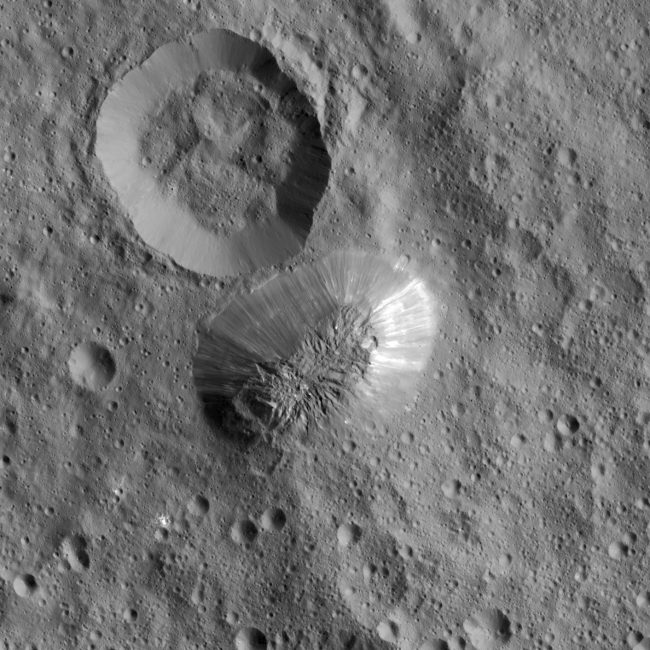
Volcanos on Earth are fueled by magma or molten rock. But the dwarf planet Ceres – which orbits the sun in the asteroid belt between Mars and Jupiter – is too little and cold to melt silicate rock in its interior. And yet scientists see a steep-sided mountain on Ceres that resembles earthly volcanoes. And so scientists have concluded that this mountain, which they call Ahuna Mons and which is about half the height of Mount Everest, is an ice volcano on Ceres, what they call a cryovolcano. They’re now questioning whether Ahuna Mons might have some hidden older siblings, ice volcanoes that flattened and vanished over millions of years. They announced on February 2, 2017 that they’ve now tested a likely way that vanishing act could occur.
A new paper on this subject has been accepted for publication in Geophysical Research Letters, a peer-reviewed journal of the American Geophysical Union.
Michael Sori of the Lunar and Planetary Laboratory at the University of Arizona commented:
Imagine if there was just one volcano on all of Earth. That would be puzzling…
We think we have a very good case that there have been lots of cryovolcanoes on Ceres, but they have deformed.

These scientists’ statement explained:
Ceres has no atmosphere, so the processes that wear down volcanoes on Earth – wind, rain and ice – aren’t possible on the dwarf planet. Sori and his colleagues hypothesized that another process, called viscous relaxation, could be at work.
Viscous relaxation is the idea that just about any solid will flow, given enough time. For example, a cold block of honey appears to be solid. But if given enough time, the block will flatten out until there is no sign left of the original block structure.
On Earth, viscous relaxation is what makes glaciers flow, Sori explained. The process doesn’t affect volcanoes on Earth because they are made of rock, but Ceres’ volcanoes contain ice – making viscous relaxation possible. On Ceres, viscous relaxation could be causing older cryovolcanoes to flatten out over millions of years so they are hard to discern. Ceres’ location close to the sun could make the process more pronounced, Sori said.
Sori and his colleagues wanted to test the idea that viscous relaxation could cause ice volcanoes on Ceres to flatten out. So they created a computer model, using the actual dimensions of Ahuna Mons to predict how fast the mountain might be flowing. They ran the model assuming different water contents for Ahuna Mons – ranging from 100 percent water-ice to 40 percent water-ice, Sori explained.
Their conclusion was that Ahuna Mons would need to be composed of more than 40 percent water-ice to be affected by viscous relaxation. Assuming that it is, Sori estimates that Ahuna Mons should be flattening out at a rate of 30 to 160 feet (10 to 50 meters) per million years.
That’s fast enough to render cryovolcanoes unrecognizable in hundreds of millions to billions of years. And that conclusion suggests there might have been other ice volcanoes on Ceres in the past. If so, why is Ahuna Mons still there? Simply because it’s so young. Sori said:
Ahuna Mons is at most 200 million years old. It just hasn’t had time to deform.
The next step for Sori and his team will be to try and identify the flattened remnants of older cryovolcanoes on Ceres.
Read more about this study via AGU
Read more about Dawn mission findings related to Ahuna Mons in this September 6, 2016 update

Bottom line: Scientists ran a computer model that suggests Ahuna Mons – an ice volcano on dwarf planet Ceres – is even now flattening out. If so, there may have been other ice volcanoes on Ceres in the past.











